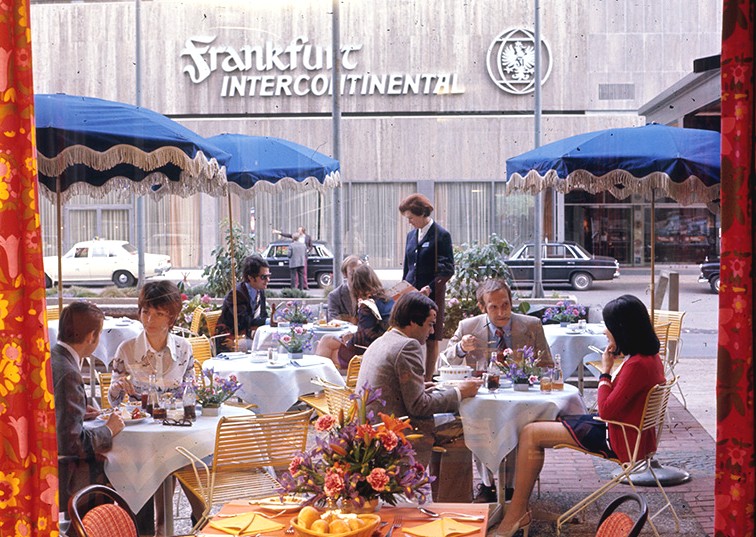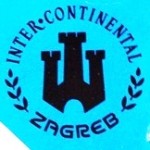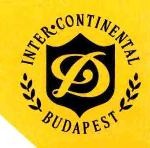IHC properties quickly became social hubs for expat communities and affluent and influential residents, who gathered at the rooftop restaurants, lobby lounges, and glittering swimming pools. And nowhere was this cosmopolitan vibe more evident than at the Phoenicia InterContinental Beirut. The first modern, luxury hotel to be built in the Middle East by a major international hotel brand, The Phoenicia was designed by the noted American architect, Edward Durell Stone. Rising over Beirut’s fabled Corniche and overlooking the blue Mediterranean, the hotel’s impressive marble lobby, sweeping staircases, high ceilings, brass tables and rich carpets reflected the exotic glamor of the Levant. A young boy in traditional dress greeted guests with cups of thick Turkish coffee poured from a beautiful brass pot. The gesture was appreciated by tired crews, eager to gain a second wind for a night out in Beirut’s discos.


The Phoenicia’s oval-shaped pool, lined with mosaic tiles, was a center for political intrigue, business deals, and romantic encounters. It also featured some of the best people-watching on the planet. The deep end of the pool dropped down about 20 feet, giving patrons of the Sous La Mer Bar a prime view of bikini-clad swimmers through its floor-to-ceiling windows. The hotel was especially popular with sheiks from neighboring and more religiously observant Muslim countries who, then and now, flocked to the bars, nightclubs, and casinos of more permissive Beirut.
And while Pan Am stewardesses were in demand throughout the airline’s system, the local Lotharios in Beirut were especially persistent. Some would buy the crew room list from the desk clerk and call each room. I remember that my roommate and I had hardly put our bags down in our room when the phone rang. A heavily accented male voice began. “Allo Miss Sweeney, I see you in the lobby, and you are very beautiful. Will you have dinner with me tonight?” I hung up and seconds later, the phone rang again. “Allo Miss Jones? I see you in the lobby……”
Crises and War
Sometimes, InterContinentals were used in times of crises, functioning as a staging area when Americans had to be evacuated from a war zone. Too often, they were the targets of political actions and terrorists. Hotels in Amman, Ceylon, and Beirut, were attacked. The beautiful Phoenicia, caught in the crossfire of the Lebanese Civil War (1975-1976), was destroyed and remained a bombed-out ruin until its restoration in 2000.
During the reign of Shah Mohammad Reza Pahlavi, Tehran was a popular layover spot, where crews shopped in the bazaars for brass, carpets and gems. Following the Iranian revolution in 1979, Pan Am ceased flying to Iran. The InterContinental Tehran housed few guests, other than journalists covering the Iranian Hostage Crisis, as American diplomats were held by Revolutionary Guards. The hotel stayed open as an IHC until it was taken over by the government. Today, it is shabby and run-down, a ghost of its former five-star splendor.
European Grandeur

In Europe, InterContinental’s presence grew, putting Pan Am flight attendants in such famous hotels as Le Grand Hotel in Paris, a Belle Époque beauty with views of the Opera House and the Louvre and home to the legendary Café de la Paix. The financial capital of Frankfurt was also a major air hub where Pan Am operated and crew members were a fixture at the IHC Frankfurt on the banks of the River Main.
Well before the infamous “Iron Curtain” parted, Pan Am and IHC were a presence in Eastern Europe with flights to several satellite countries. There were InterContinentals in Bucharest, Budapest, and later Warsaw and Moscow.

African Exotica
Some crew lodgings in Africa were less than luxe, particularly in Roberts Field, in Monrovia, Liberia. Crews walked directly from the planes, across the runway to the Roberts Field Hotel on the edge of the jungle. They would have been issued anti-Malaria pills and inoculated against Cholera for the trip. The so-called “African Kings and Queens” were a hardy group!

Far more elegant accommodations awaited in Abidjan, on the Ivory Coast, where the IHC boasted one of the few ice skating rinks in Africa. In Kenya, the elegant InterContinental was a haven in the midst of Nairobi, close to the city’s colorful markets and a short drive from Nairobi National Park.

A Passage to India

On the Indian Subcontinent, InterContinentals in New Delhi and Karachi offered excellent restaurants, fine shops and spas where massages and facials, fit for a maharani, could be had. The Karachi InterContinental boasted spectacular Mogul-inspired architecture, but on a layover in the late 60s I was taken aback when I opened the guest room curtains to a grim sight. Right behind the hotel was a Tower of Silence, where dead bodies were placed, and vultures circled. The Towers are part of a 3,000-year-old Zoroastrian tradition of disposing of the dead body by exposing it to scavenger birds. They provide an economical, ecologically sound and religiously motivated service, but it was not a sight I expected to see from the window of a five-star hotel! A perplexing addition to the IHC portfolio in Pakistan were two hotels on the Pakistan-China border that appeared in the brochures all but hidden by trees and shrubs and said to be manned by CIA China Watchers.
From Samoa to Shinjuku- IHC Dominates Asia/Pacific

InterContinental continued to expand in the Asia/Pacific region, and Tokyo’s Keio Plaza was the place where dozens of Pan Am crews converged. The tallest hotel in Japan, it often swayed when tremors hit Tokyo and crew members joked it might soon be the longest. With over a dozen restaurants and countless shops, crews could dine and shop in several languages and take advantage of the hotel’s prime location in the heart of Tokyo’s dazzling Shinjuku district.
The Manila IHC was an oasis in the midst of the teeming capital, and female flight attendants were advised not to go out at night unless accompanied by a male crew member. But the safety of the hotel was called into question when a shootout occurred in the disco and the crew barely escaped the crossfire.

In Singapore, noted architect John Portman designed one of Asia’s first atrium hotels for IHC. On the Island of Papeete in Tahiti, the InterContinental was an inverted pyramid built into the side of a mountain. The lobby was at the top and guests took the elevator down to rooms with stunning Pacific views. The black sand beach below was perfect for snorkeling and fishing – we even caught our own sashimi! The Rainmaker InterContinental in Pago Pago was a welcome addition to the crew layover list. Prior to that, crew accommodations were in an apartment building where we cooked our meals of steaks we brought with us from Auckland.
U.S. Expansion and Historic Preservation
In the 1980s, InterContinental launched a major expansion in the US. Hotels were built in Atlanta, Boston, Hilton Head, Houston, Los Angeles, Miami, New Orleans and San Diego. InterContinental also added a new and important element to its services to owning companies – the restoration of landmark hotels. The company carefully restored such legendary properties as The Mark Hopkins in San Francisco,

The St. Anthony in San Antonio, The Barclay in New York, The Willard in Washington, and The InterContinental Chicago, a converted Masonic Temple on Chicago’s Magnificent Mile. Overseas, historic gems including The Meurice, the InterContinental in Paris and The Mayfair in London, were carefully polished and preserved. In Sydney, Australia’s historic Treasury Buildings were revamped to accommodate the lobby, restaurants, and shops of the new InterContinental Sydney and its modern guest room tower.

The Jewels in the Pan Am Crown Are Sold
Pan Am had already sold its iconic Pan Am Building to the Metropolitan Life Insurance Company in 1981. That same year, the increasingly cash-strapped airline was forced to put another “jewel in the crown” on the block. InterContinental Hotels Corporation with 83 hotels in 47 countries was sold for $0.5 billion to Grand Metropolitan, a major British conglomerate. Pan Am and IHC maintained some business and marketing ties until the hotels were sold again to the Japanese Saison Group.
Juan Trippe’s Global Vision Endures
Today, IHC is back in British hands as part of Bass, LLC, the parent company of InterContinental Hotels Group (IHG). IHG is a global organization with a broad portfolio of hotel brands.
Still expanding, IHG operates 179 luxury InterContinental Hotels & Resorts on every continent with 51 new properties planned. Today, InterContinental is an award-winning brand, winning accolades such as the coveted title of “World’s Leading Hotel Brand” at the World Travel Awards in 2014 – an award it has held for six consecutive years.
In 1991, Pan American World Airways finally folded its proud wings. But the global vision of Juan Trippe, reluctant hotelier, endures.
Anne Sweeney flew for Pan Am from 1964-1975 and worked in the Corporate Communications Departments of both Pan Am and InterContinental Hotels.





I flew for PanAm from 1970-1976 and miss it every day – traveling the world was truly the adventure of a lifetime! I tear up every time I see a 747 fly overhead – which is becoming more and more rare. My favorite hotel was the beautiful cliffside Taharaa in Papeete – every room had a balcony with a spectacular view of Moorea Island in the distance. Thanks for the wonderful memories!
Wonderful story! Happy memories of IHC layovers all around the world! Many thanks, Anne.